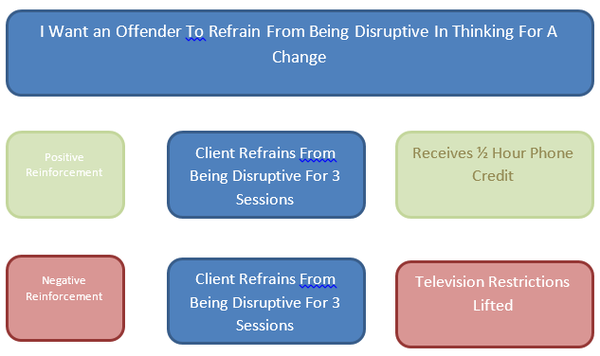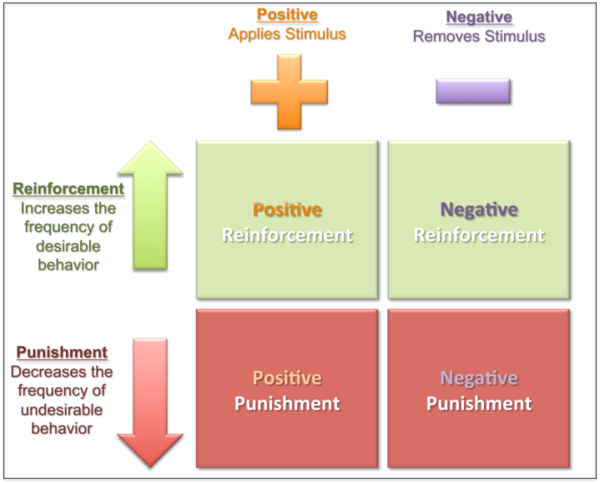 Risky Business
By Karley Jorgensen, EBP Facilities Coordinator
|
George W. Bush stated, “America is the land of the second chance - and when the gates of the prison open, the path ahead should lead to a better life.” That is our goal at the Minnesota Department of Corrections(DOC), to assist offenders in building a better life, which in turn creates safer communities. This is so crucial to the work we do that it opens up our mission statement, “Reduce recidivism by promoting offender change…” Now, let’s get real, we are sometimes the land (or department) of third, fourth, fifth, or twentieth chances! How we determine who gets the chance to participate in services and programming is the topic and title of this article.
Ideally, programming, interventions, and intensive services are reserved for offenders at the highest risk to reoffend (which we identify based on the fancy new automated MnSTARR 2.0 ). So here is the good news and bad news in our business. The good news: as a department, we have some amazing staff members who are knowledgeable, dedicated, and invested in guiding offenders through the change process by utilizing evidence-based practices with fidelity. The bad news: the number of offenders in need of programming and interventions far exceeds our ability and resources to serve. As we operate with limited resources, it is essential that we mindfully and strategically provide offenders with services, especially programming which demonstrates the ability to reduce recidivism. The research which informs this article, is the research on the Risk-Need-Responsivity (RNR) Model*.
The risk principle (from the RNR Model), highlights the importance of matching offenders risk levels to provided interventions. The following three considerations are incredibly important when selecting offenders to receive services:
1.
Participation in interventions, programs, and services should be reserved for
offenders with the highest risk of recidivism. We are hoping to get the
most bang for our buck.
2. The most intensive interventions should be
targeted to the highest risk offenders. Again, to reduce recidivism, we
have to focus on those most likely to reoffend.
3. Providing intensive services to low risk
offenders can actually increase their risk of recidivism. We need to
utilize our resources in the most effective way. If we aren’t mindful of
risk levels, we may be wasting resources, and at worst, increasing risk of
recidivism instead of decreasing it.
From my years facilitating group programming, I know all too well that low risk offenders tend to be motivated, insightful, and cooperative group members, while high risk offenders tend to be challenging and resistant. There may be temptation to provide services to low risk offenders, or to sprinkle some low risk offenders into groups with high risk offenders as those low risk offenders may support the content and provide examples that reinforce the material. However, again, placing low risk offenders in programming with high risk offenders can increase the low risk offender’s risk of recidivism. This isn’t to say that low risk offenders don’t have criminogenic needs, as we know from those with an LS/CMI that some do. Rather, it is to say that high risk offenders have more criminogenic needs and represent the biggest risk to our communities and therefore require the most intensive services.
The Effective Interventions Committee serves the department by reviewing program proposals and providing recommendations to align emerging programs and practices with what research has proven to be most effective in reducing recidivism. One of the most common and most important recommendations made is to ensure that programming is reserved for offenders at the highest risk to reoffend. It behooves us to target high risk offenders who represent the biggest challenge to work with and also the biggest risk to our communities. Fortunately, with lots of time and perhaps repeated failures and returns to prison, they also represent the biggest reward when they achieve positive change!
Imagine the following scenario: I am suffering from a headache and I jump into my car and head to the local emergency room. Once I arrive, I wait for several hours in a crowded triage department surrounded by individuals with varying illnesses and injuries. When I am finally seen, the provider takes my vitals and accurately diagnoses a headache then provides some ibuprofen with a discharge recommendation that I drink more water and use OTC medications if needed in the future. My needs were met and my headache was alleviated. However, a couple days later, I began feeling awful and it would seem contracted a virus while in the waiting room. In the end, while I got my needs met, I was not an appropriate candidate for emergency medical services. I created additional work for staff members, potentially delayed admission for patients in far more imminent danger than myself, and ultimately alleviated my headache while also contracting a worse affliction. The costs of going to the ER in this situation clearly outweighed the benefits.
Now, let’s apply this same logic to offender programming and services. Providing low risk offenders with intensive services is like sending someone with a headache to the ER, it may be helpful, but you run the risk of actually making things worse. It is an inefficient, wasteful use of precious resources and is potentially damaging (can increase low risk offenders chances of reoffending). While low risk offenders may be wonderful program participants, providing them with intensive services isn’t the best use of our resources. The ER is intended for, and most effective when used for individuals with imminent medical concerns. Just as intensive services are most effective when reserved for high risk offenders.
Every interaction is an opportunity to support offender change. Just like collecting pennies in a piggy bank, one penny may be insignificant, but by collecting pennies overtime, the bank will fill up. The same is true with change. One interaction, intervention, or program will not change an offender. However, by receiving services and participating in programming overtime, change occurs. Just as security is everyone’s job, so too is reentry!
In the movie Risky Business, Miles states, “Freedom brings opportunity, opportunity makes your future.” As we serve incarcerated individuals, we are most successful when we focus not on their past, but on their future, we create opportunities for high risk offenders to recognize and address their criminogenic needs which then hopefully provides them with a future characterized by successful reintegration into the community where they can remain law abiding, productive citizens.
5 Mistakes Corrections Programs Make
By Charles "Pete" Sutter, MNSIRR Regional Coordinator
Most people involved in delivering correctional programming want to make a positive impact on the lives of the people they serve. Far too often, mistakes are made in adhering to best practices. Common mistakes have been shown to result in low to no impact at best, and in many cases will actually increase the risk of re-offense.
Theories regarding the effectiveness of correctional interventions have shifted over the past few decades. We have moved away from a theory of “nothing works” to a theory that uses science and data to discover what works in changing offender behavior. “Without some form of human intervention or services, there is unlikely to be much effect on recidivism from punishment alone.”
The evidence indicates that while treatment is more effective in reducing recidivism than punishment, not all treatment programs are equally effective. Researchers have poured over large body of literature and existing data that encompasses correctional treatment programs to discover “What Works” in changing offender behavior. Scientist no longer look at just one study. Nor do they simply condense the existing research. The most current and informative method is called meta-analysis and is the statistical summary of existing literature. Through this method, scientist have distilled what are widely accepted as the principles of effective intervention.
 |
|
This article will discuss the first of 5 common mistakes correctional programs make in adhering to these principles. |
1. They do not have clearly defined targets.
One of the most important decisions a program should make early on is its target population. Appropriate targets can make or break a program in terms of effectiveness. Clearly defined admittance and exclusionary criteria is paramount in ensuring participants are both a good fit and in need of the services being offered. Programs that do this well use resources more efficiently, have better outcomes and are more likely to reduce recidivism.
Effective, well-designed admittance and exclusionary criteria are developed through the use of two elements:
1. A clear mission statement, and
2. Policy and practice guidelines that support the mission and outline who should and shouldn’t receive services.
This statement, although somewhat broad and not a perfectly analogous example when discussing programming, is a great starting point for illustrating how well-crafted mission statements can inform a program’s admittance and exclusionary criteria.
The DOC’s mission statement does several things well. It speaks to the departments goal (recidivism reduction), the type of services offered (programs shown to change behavior), and describes the people to be served (offenders). Ideally at a program level you would want to define the risk level.
The second element of effective admittance and exclusionary criteria is whether there are policy and practice guidelines that support the mission and appropriate targets. Continuing with our example, DOC Policy 204.005 defines a program as, “a facilitated curriculum that is consistently delivered on a regular basis, has a targeted population, addresses risk and need, has measured outcomes, has specific admission and discharge criteria, and is evidence based.” This is a great attempt at a policy driven commitment to evidence based practices, and provides the foundation for appropriate targeting.
We can also take this a step further and look at policy regarding a specific intervention endorsed by the department. In particular, DOC Policy 203.010 defines the offenders who are appropriate for integrated case management (ICM) services. It states, “Offenders who are high or very high risk as assessed by the MnSTARR . . . receive integrated case management services.” Additionally ICM is defined as, “[E]nhanced case management using evidence based practices . . . such as motivational interviewing, case planning, effective intervention, and comprehensive, collaborative release planning with the purpose of reducing an offender’s risk of recidivism.” This is a good example of an intervention with clearly defined and appropriate targets.
With regard to exclusionary criteria, the most important consideration is that there is written policy of which staff is aware and follows. Some examples of such criteria are untreated chemical dependency and emotional problems, sexual offenses, gang affiliation, history of violence or arson . . . etc. The list goes on, but the science is clear; if a program is unable to accommodate and treat certain clients, then they should not be included in programming.
In summary, programs are more effective when they serve the right clients with the right interventions. A well-crafted mission statement and supporting policy will help programs ensure appropriate targets. There should be an emphasis on risk and need, and exclude offenders otherwise unsuitable for the services offered.
This series will continue in upcoming newsletters with the other common mistakes programs make in adhering to the principles of effective intervention. Including:
2. They do not assess participant’s risk, need and responsivity factors with validated tools
3. They do not case plan on an the individualized needs of clients
4. They use “homespun” interventions
5. They do not evaluate their staff on service delivery
Featured in each newsletter, we'll explore concept's of "what works" to change lives.
Exploring “What Works”
Effective Reinforcement
By Charles "Pete" Sutter, MNSIRR Regional Coordinator
This is a continuation of a discussion from previous newsletters centered on Core Correctional Practices. In this edition we will focus on Effective Reinforcement. There are many tools at our disposal that are proven to influence offender change and reduce recidivism. Of them, using effective reinforcements is among the easiest and lowest cost to implement.
Effective Reinforcements
Effective reinforcement is a form of operant conditioning. It involves the addition and taking away of a reinforcing stimulus to influence future behavior. When a favorable outcome, event, or reward occurs after an action, that particular response or behavior is more likely to be strengthened and happen again. Effective reinforcements encompass both positive and negative reinforcements. This concept can be tricky, but don’t confuse negative reinforcement with punishment or sanctions. Instead, it’s the removal of a stimulus. This concept is illustrated in the following charts.
  There are a just a few things to keep in mind when using effective reinforcement. You should do the following things when administering reinforcement:
• Must be administered during or immediately following the behavior target
• Must be contingent on performing the desired behavior
• Should be administered consistently at first, and then intermittently
• Offender should be aware that the reinforcement is a consequence of performing the target behavior
The following are some examples of effective reinforcement that can be used in institutional settings:
• Specific praise or feedback on performance
• Extra food
• Free time
• Group recognition
• Modified television, radio and phone privileges
• Badges, certificates and ribbons
• Playing host to visitors
The concept of positive reinforcement does not contradict or even compromise the concept of accountability, and when used properly, can make your job easier and prevent future crime. Look for creative ways to incorporate this technique into your daily routine and comment below.
Sources:
Latessa, Edward, Core Correctional Practices Study Guide, University of Cincinnati Corrections Institute (2015).
Redmond, Bryan, Reinforcement Theory, www.psu.edu/display/PSYCH484 (2015).
|